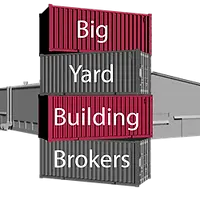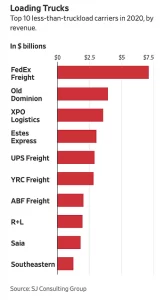Efforts to meet growing e-commerce consumer demand have less-than-truckload carriers handling more freight
Companies with less-than-truckload delivery operations are seeing growing freight demand. PHOTO: YRC WORLDWIDE By Jennifer Smith Feb. 15, 2021 8:00 am ET
A slice of the trucking industry critical to retail and industrial supply chains is on a roll as the pandemic-driven boom in online shopping reshapes U.S. distribution maps. Companies including Old Dominion Freight Line Inc., ArcBest Corp. and Saia Inc. are expanding as businesses try to make their supply chains more nimble to catch up to rapidly shifting consumer demands. That is driving more freight into less-than-truckload operations, where trucking companies carry shipments from multiple customers on a single trailer, boosting revenues and pricing leverage for the carriers. Old Dominion, the second-largest operator in the sector after FedEx Corp.’s FedEx Freight unit, this month said it has added nine service centers to its U.S. network since the start of 2020 and plans several additions this year. That puts the Thomasville, N.C.-based operator among the businesses that are growing even as the coronavirus pandemic batters big parts of the U.S. economy. Operators in the highly competitive sector are benefiting as businesses scramble to meet surging e-commerce demand from shoppers who are ordering everything from paper towels to furniture online. WSJ NEWSLETTER Notes on the News The news of the week in context, with Tyler Blint-Welsh. I would also like to receive updates and special offers from Dow Jones and affiliates. I can unsubscribe at any time.I agree to the Privacy Policy and Cookie Notice. SIGN UP Companies that used to ship truckloads of merchandise to big, remote distribution centers are opening compact warehouses in cities and suburbs, where space constraints require smaller and more frequent shipments to keep goods in stock. Loading TrucksTop 10 less-than-truckload carriers in 2020, byrevenue.In $ billionsSource: SJ Consulting Group FedExFreightOldDominionXPOLogisticsEstesExpressUPS FreightYRC FreightABF FreightR+LSaiaSoutheastern$0$2.5$5$7.5 “LTL gives retailers and e-commerce providers a lot more flexibility in their supply chain,” said Tony Brooks, president of XPO Logistics Inc.’s less-than-truckload business. “They’re holding more just-in-time inventory that requires shorter notice and lead times, so they’re increasingly turning to LTL companies to ship products quickly.” Adam Satterfield, chief financial officer at Old Dominion, said the acceleration of online shopping is the biggest pandemic-driven change to business at the trucker, where retail accounts for between 25% and 30% of revenue. As companies add smaller facilities closer to consumers, he said, “What could have been a truckload of goods now needs to be a few pallets of product brought in more frequently.” The growing demand helped push Old Dominion’s operating income to $254.3 million in the fourth quarter, up 35.1% from the same period in 2019. The company generated $1.07 billion in revenue in the quarter, up 6.4% year-over-year. “These e-commerce trends will continue to be a tailwind for the industry,” said Mr. Satterfield. Fort Smith, Ark.-based trucker ArcBest is also riding higher as homebound consumers have stepped up online purchases of oversize items like furniture and exercise equipment, boosting home-delivery business at the company’s LTL segment, ABF Freight. At one point last year “we had a 48% increase in that business,” ArcBest Chief Executive Judy McReynolds said in a Feb. 2 earnings call. “I do think that the addressable LTL market has grown. And it is because of e-commerce,” which she said contributed to ABF Freight’s fourth-quarter gain in revenue to $554.4 million, up 8% from the previous year. NEWSLETTER SIGN-UP The Logistics Report Top news and in-depth analysis on the world of logistics, from supply chain to transport and technology. PREVIEW SUBSCRIBE Saia, a Johns Creek, Ga., carrier focused on the Southeast, is raising its capital spending from $218.8 million last year to about $275 million this year after its net profit nearly doubled in the fourth quarter and revenue rose 7.5% to $476.5 million. The upswing follows a volatile year for trucking companies, which saw shipping volumes plunge in April and May amid widespread lockdowns aimed at limiting the spread of Covid-19. The freight market picked up in the second half of 2020 as businesses rushed to restock inventories and retailers brought in holiday-season merchandise. The spring downturn took a toll on Overland Park, Kan.-based Yellow Corp. , another large LTL carrier, which operated as YRC Worldwide Inc. until changing its name earlier this month. The company, which has long struggled financially, took a hit during the Covid-19 shutdowns and last year took out a $700 million federal coronavirus-relief loan to shore up its finances. Now the company is bringing in new trucks to refresh its aging fleet and executives say shipping volumes have been improving since October. Yellow lost $18.7 million in the fourth quarter on revenue that was flat compared with the year before at $1.17 billion, but its adjusted earnings before interest, taxes, depreciation, and amortization rose 22.4% from the previous year, to $57.9 million for the quarter. “The large online retailers are opening warehouses weekly and those warehouses are getting closer and closer to the population centers,” Yellow Chief Executive Darren Hawkins said. “And when they open it, we’re stocking it.”








